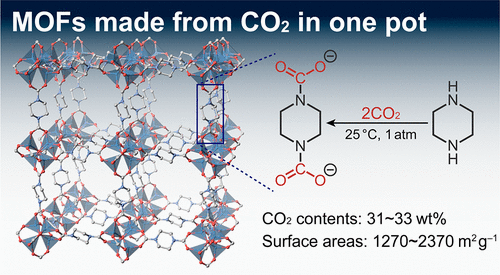
京都大学 icems:在常温常压下转化 CO2:多孔材料 (PCP / MOF)
-一种新的碳中和方法-
京都大学icems
JEOL共振
理研
研究组
我们已成功开发出一种在室温和常压下将 CO2 转化为有用多孔材料 (PCP / MOF) 的新方法。
常规问题:
将二氧化碳转化为有用的材料
在高温高压下反应,
使用昂贵的贵金属催化剂是必不可少的。
这个新的发展:
研究组
CO2 与称为胺的有机分子反应。
得到的有机分子直接与金属离子反应产生。
我们开发了一种可以同时合成 PCP/MOF 的新方法。
转换为 PCP / MOF:
我设计了胺和金属离子的组合。
可将常温常压下的CO2转化为各种PCP/MOF。
分子水平的结构分析:
进行了“使用固态核磁共振光谱(NMR)的同步辐射X射线衍射测量和分析”。
在 PCP/MOF 的分子水平内有规律地形成 1 nm 的孔。
结果证明,它的结构由每重量超过 30% 的二氧化碳组成。
该解决方案的应用:
通过设计金属离子和胺的组合,
合成各种结构和功能的多孔材料,
含有大量杂质的工厂废气中的 CO2 等。
预计将扩大回收目标。
什么是多孔材料?
内部具有无数微观细胞(孔)的固体。
一个例子是“净水器和空气净化器中的活性炭和沸石”。
近年来,多孔材料的研究得到了越来越多的发展。
它用于从能量存储到气体分离的广泛领域。
专注于PCP / MOF:
在这项研究中,我们专注于 PCP / MOF,这是一种多孔材料。
PCP/MOF 具有“由金属离子和有机化合物(可交联配位键)组成的类似丛林健身房的结构”。
自 90 年代后期问世以来,已开发出 90,000 多种 PCP/MOF。
其中一些已被实际用于半导体储气。
以CO2为原料合成PCP/MOF:
然而,它们都不是以二氧化碳为原料制成的。
其原因是“一种从CO2中轻松产生可交联配位键的方法,适用于PCP/MOF合成”。
新闻 | 京都大学 icems
https://www.icems.kyoto-u.ac.jp/news/6311/
在常温常压下成功将二氧化碳转化为多孔材料 | RIKEN
https://www.riken.jp/press/2021/20211008_2/index.html
One-Pot, Room-Temperature Conversion of CO2 into Porous Metal–Organic Frameworks
The conversion of CO2 into functional materials under ambient conditions
is a major challenge to realize a carbon-neutral society.
Metal–organic frameworks (MOFs)
have been extensively studied as designable porous materials.Despite the fact that CO2 is an attractive renewable resource,
the synthesis of MOFs from CO2 remains unexplored.
Chemical inertness of CO2
has hampered its conversion into typical MOF linkers such as carboxylates without high energy reactants and/or harsh conditions.Here,
we present a one-pot conversion of CO2 into highly porous crystalline MOFs at ambient temperature and pressure.Cubic [Zn4O(piperazine dicarbamate)3]
is synthesized via in situ formation of bridging dicarbamate linkers from piperazines and CO2 and shows high surface areas (∼2366 m2 g–1) and CO2 contents (>30 wt %).
Whereas the dicarbamate linkers
are thermodynamically unstable by themselves and readily release CO2,
the formation of an extended coordination network in the MOF lattices
stabilizes the linker enough to demonstrate stable permanent porosity.
Journal of the American Chemical Society